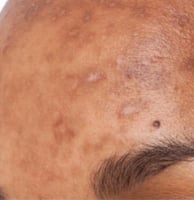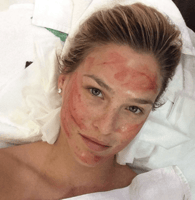Melasma is a common skin condition that is characterized by the appearance of dark, discolored...
Dermaplaning - Everything You Need to Know About This Skin Care Trend
Dermaplaning is a skin care treatment that has gained popularity in recent years. It’s also known as “epidermal stripping” or “ghosting” and involves the use of a small surgical blade to remove fine layers of dead skin cells and peach fuzz from the face, neck and décolleté. If you aren’t already familiar with dermaplaning, you probably have many questions about this popular skin care treatment.

So what is dermaplaning? How does it work? Is it safe? We answer all of your burning questions regarding this intriguing skincare technique below.
What is Dermaplaning?
Dermaplaning, also known as epidermal stripping or ghosting, is a skin care treatment that exfoliates the face, neck and décolleté by removing the top layer of dead skin cells and peach fuzz with a small surgical blade. Dermaplaning is similar to microdermabrasion, but with a few key differences. Unlike microdermabrasion, dermaplaning is not done in the spa or medspa by an aesthetician. Dermaplaning is also different from chemical peels and microdermabrasion in that it does not use any type of acid or solution to exfoliate the skin or remove dead skin cells.
Who Can Benefit from Dermaplaning?
Dermaplaning is a safe skin care procedure that any skin type can benefit from, including those with sensitive or acne-prone skin. Dermaplaning is an excellent choice for those who are looking for quick and noticeable results or for those who want to get rid of peach fuzz. Dermaplaning is sometimes performed as part of a facial or as a stand-alone treatment. Dermaplaning can be used to address a number of skin concerns, including:
- Acne and acne scars
- Exfoliation
- Dull or uneven skin
- Hyperpigmentation
- Clogged pores
- Blackheads
- Fine lines and wrinkles
Side Effects of Dermaplaning
As with any skin care procedure, there are risks associated with dermaplaning. These include infection, bleeding, scarring, and hyperpigmentation. If you have sensitive skin or have had any adverse reactions to chemical peels or microdermabrasion in the past, you should consult with your dermatologist before undergoing dermaplaning. Your doctor can advise you as to whether dermaplaning is a good choice for you based on your skin concerns and skincare goals.
How Does Dermaplaning Work?
Dermaplaning works to exfoliate and gently remove the uppermost layer of dead skin cells, as well as any peach fuzz. It also loosens up deeper, clogged pores to help unclog them. Dermaplaning has many benefits, including improved overall skin clarity, reduced appearance of fine lines and wrinkles, a more even skin tone, reduced pore size and oil production, and a reduction in breakouts. Dermaplaning is best done when your skin is in the active phase of growth. This typically occurs from the end of your menstrual cycle until the middle of your menstrual cycle, when you’re experiencing a surge in estrogen. This is when your skin is the thinnest and easiest to remove.
How to Care for Your Skin After Dermaplaning?
After dermaplaning, you should follow a skincare routine that will help your skin recover and stay healthy. Your skincare routine should include gentle cleansers, a good moisturizer and sunscreen. These products will help keep your skin hydrated and encourage healthy cell turnover.
You may be able to go back to your normal skincare routine after dermaplaning, but skincare specialists advise against it. Your skin is more sensitive after dermaplaning and can easily become irritated by harsh products.
If you want to further your skin care journey, you can try derma rolling. Derma rolling is a DIY option that can be done in the comfort of your home. You can use a derma roller to exfoliate your skin and increase blood flow to the skin.
The Bottom Line
Dermaplaning is a safe and effective treatment for improving skin clarity and reducing the appearance of fine lines and wrinkles. Dermaplaning is not for everyone, however, and it is important to consult with your dermatologist or provider before beginning any new skin care routine.
Disclaimer:
The information provided in this article is for educational purposes only and is not intended to replace, substitute, or delay the advice of a qualified healthcare professional. There are risks associated with any skin care treatment, including dermaplaning. Results are never guaranteed and some conditions may return or worsen after treatment. It is important to consult with a dermatologist or other qualified healthcare professional before undergoing any new skin care procedure. The use of this article is subject to our terms and policies, which can be found on our website. Photos are for entertainment purposes only.



